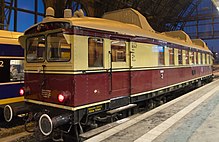Buxtehude-Harsefelder Railway
The Buxtehude-Harsefelder Eisenbahn (BHE) is a former railway company that existed from 1913 to July 1, 1993. After years of delay due to the First World War, it opened the full-track , 15 km long Buxtehude – Harsefeld line from the city of Buxtehude on the Hamburg – Stade – Cuxhaven main line to Harsefeld on the Bremervörde – Buchholz branch line on December 19, 1928 . When the company was founded, it was owned by the State of Prussia and the Province of Hanover , the Jork district (from 1932 the Stade district ), the city of Buxtehude, the municipality of Apensen and the Flecken Harsefeld. After the Second World War, the state of Lower Saxony took over the shares of the state and province.
history
With the opening of the Bremervörde – Buchholz railway line in 1902, the city of Buxtehude saw the danger that traffic would bypass it. After a request for the establishment of a state railway connection was rejected in 1905, the application for the construction of a private railway was made in 1909, which was approved. The Kleinbahn Buxtehude-Harsefeld GmbH was founded in 1913 and the name was changed in 1942. Construction began in 1914, but in 1917 it finally came to a standstill. The superstructure material that had already been procured had to be sold. Due to inflation, further construction was out of the question for the time being. After the financing had been reorganized, construction began in February 1928 and the line was opened on December 21, 1928. Originally a further construction to Zeven was planned, the planning was finished in 1931, but it did not come to the construction.
The operation of the line was taken over in 1933 by the Landeskleinbahnamt in Hanover, which later became the Lower Saxony State Railway Office , and from 1959 the Osthannoversche Eisenbahnen AG (OHE).
During the Second World War, the line remained undamaged, as the line was closed to the Reichsbahn with damaged vehicles from February 1945 to May 1946, so no traffic was possible.
In May 1969 the passenger traffic was stopped.
In 1973 the district, the city of Buxtehude and the municipalities took over the portion of the state of Lower Saxony that did not consider the route to be eligible for funding. The company was financially sound until the end. On July 1, 1993, it merged with the railways and transport services Elbe-Weser GmbH (EVB), which had already taken over the subsequent line in Harsefeld from the German Federal Railroad. As a result, through passenger traffic was started. In 2011 the line was equipped with modern signaling technology. Although the EVB trains have not used the DB route between Buxtehude and Hamburg-Neugraben since the S-Bahn was extended to Stade, the Harsefeld route is directly connected to the Niederelbe-Bahn at Buxtehude station.
passenger traffic
At the beginning there were four pairs of trains every day, and a good 60,000 passengers were carried each year. However, the economic crisis also caused these numbers to decline. It was not until the mid-1930s that they returned to their old level. From 1933 a Wismar rail bus was used, which accelerated the travel time. After the Second World War, the population and, above all, commuter traffic to Hamburg rose sharply, so that more than 200,000 passengers were carried annually. In 1950 seven pairs of trains ran on weekdays and four on Sundays. After a parallel bus line had already been introduced in 1968, passenger transport was completely converted to buses in May 1969.
Freight transport
Originally, freight traffic was entirely geared towards agriculture, with between 10,000 and 15,000 t being transported annually. After the Second World War, various companies settled on the route, which brought an increased volume of freight with them, so that more than 80,000 t were transported at the end of the 1970s. The company was also successful in attracting new customers. The relocation of sugar beet transports to the road from 1992 (1981: 37,000 t) and the emigration or closure of some farms led to losses.
vehicles
The traffic was started with two used steam locomotives, which were sold in 1930 after the purchase of a brand new locomotive. In 1947 a second steam locomotive was bought used, which was replaced by another in 1955. In 1961 a V 36 was bought to replace the steam locomotives. Three more diesel locomotives were added later. The locomotive 223 (Deutz / 1913) parked at the BHE in 1983 is now back at the EVB and in Zeven after a period in a museum in Stade.
With the exception of the Wismar rail bus, only second-hand railcars were used in passenger transport, several of which suffered total losses in accidents and had to be replaced. The VT 175 from 1926, which is still used for museum trips, has been preserved.
literature
- Gerd Wolff: German small and private railways. Volume 10: Lower Saxony 2 . Eisenbahn-Kurier, Freiburg 2007, ISBN 978-3-88255-669-8 , p. 146-161 .

